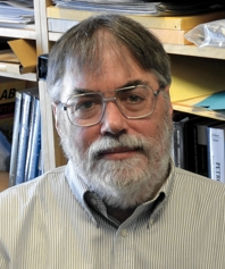
Emeriti Professor
Office Phone: 307-223-2301
P.O. Box 3006
Laramie, Wyoming 82071-3006
ESB: 3028
Email: magma@uwyo.edu
Education
Geology, PhD, The Johns Hopkins University, 1979
Geology, MA, The Johns Hopkins University, 1977
Geology, BS, University of Rhode Island, 1973
Research Projects
'Myers, J.D., B.D. Marsh, C.D. Frost and J.A. Linton, 2001, Petrologic constraints on the spatial distribution of crustal magma chambers, Atka Volcanic Center, central Aleutian arc. Contrib. Mineral. Petrol., in press.
Myers, J.D., 2001, Engaging large enrollment classes using interactive, multimedia modules built with Flash: Geol. Soc. Am. Abstracts with Programs, vol. 33, p. A124. (Invited)
Myers, J.D., and J.E. McClurg, 2001, Combining technology, group learning, hands-on activities and multimedia to promote active learning in large enrollment geoscience courses Geol. Soc. Am. Abstracts with Programs, vol. 33, p. A63. (Invited)
McElfresh, T.J, and J.D. Myers, 2001, The next generation of online petrologic research and teaching tools: integrating and extending petrologic data systems such as AADS with XML Web services: Geol. Soc. Am. Abstracts with Programs, vol. 33, p. A174.
Myers, J.D., and T.J. McElfresh, 2001, A relational database schema for managing geochemical and visual data: the Aleutian Arc Data System (AADS): Geol. Soc. Am. Abstracts with Programs, vol. 33, p. A336.
Courses
GEOL1100 - Physical Geology
GEOL3300 - Earth Resources: the necessities and limitations of modern industrial society
GEOL5610 - Geological Thermodynamics I
GEOL5620 - Geological Thermodynamics II
GEOL5640 - Advanced Igneous Petrology Seminar
GEOL5861 - Stratigraphy
Current Graduate Students
- Jeff Nelson - MS Candidate
Research Statement
Igneous petrology has entered a quantitative stage of development that combines classical approaches (i.e. field mapping, petrographic study) with analytical (major and trace element, microprobe, isotopic) and experimental studies to understand the origin and evolution of igneous rock suites. Theoretical modeling provides additional valuable constraints on the interpretation of igneous rocks. Petrographic study coupled with laboratory analysis provides the data necessary to estimate the intensive parameters of magma genesis and crystallization, the character of possible magma sources, as well as the age of igneous bodies.Isotopic analysis is also useful in identifying processes that would be difficult to recognize using other analytical procedures. At the same time, field mapping provides the basic spatial and temporal framework within which these laboratory results must be interpreted. To understand the genesis and evolution of igneous rocks, a researcher must have sound understanding of analytical methods, thermal and chemical principles, as well as a good geological background.
At Wyoming, my students and I use such an integrated approach to shed light on the petrogenesis of a diverse range of volcanic and plutonic rocks. A fully automated electron microprobe is used to acquire the types of analytical data necessary for such detailed studies. In addition, our new petrographic lab permits quantitative interpretation of the textures and mineralogy of igneous rocks. In conjunction with Professor Carol Frost, my studies have used isotopic studies to complement their petrographic and geochemical investigations. Some of our on-going research projects include:
The petrogenesis of island arc magmas (with special emphasis on the Aleutian arc).
- The quantitative petrography of volcanic rocks.
- The evolution of mafic magma during magma ascent (both from a purely petrological approach, as well as by theoretical modeling).
- Thermal and fluid dynamic constraints on magma generation, ascent and differentiation.
Teaching Statement
Students today face a job market in which they will likely change jobs many times during their career. In addition, studies show they may change professions more often than workers in the past. Consequently, students need communication, critical thinking and problem solving skills. Consequently, a class is more valuable if it provides students with the opportunities to learn these skills.

